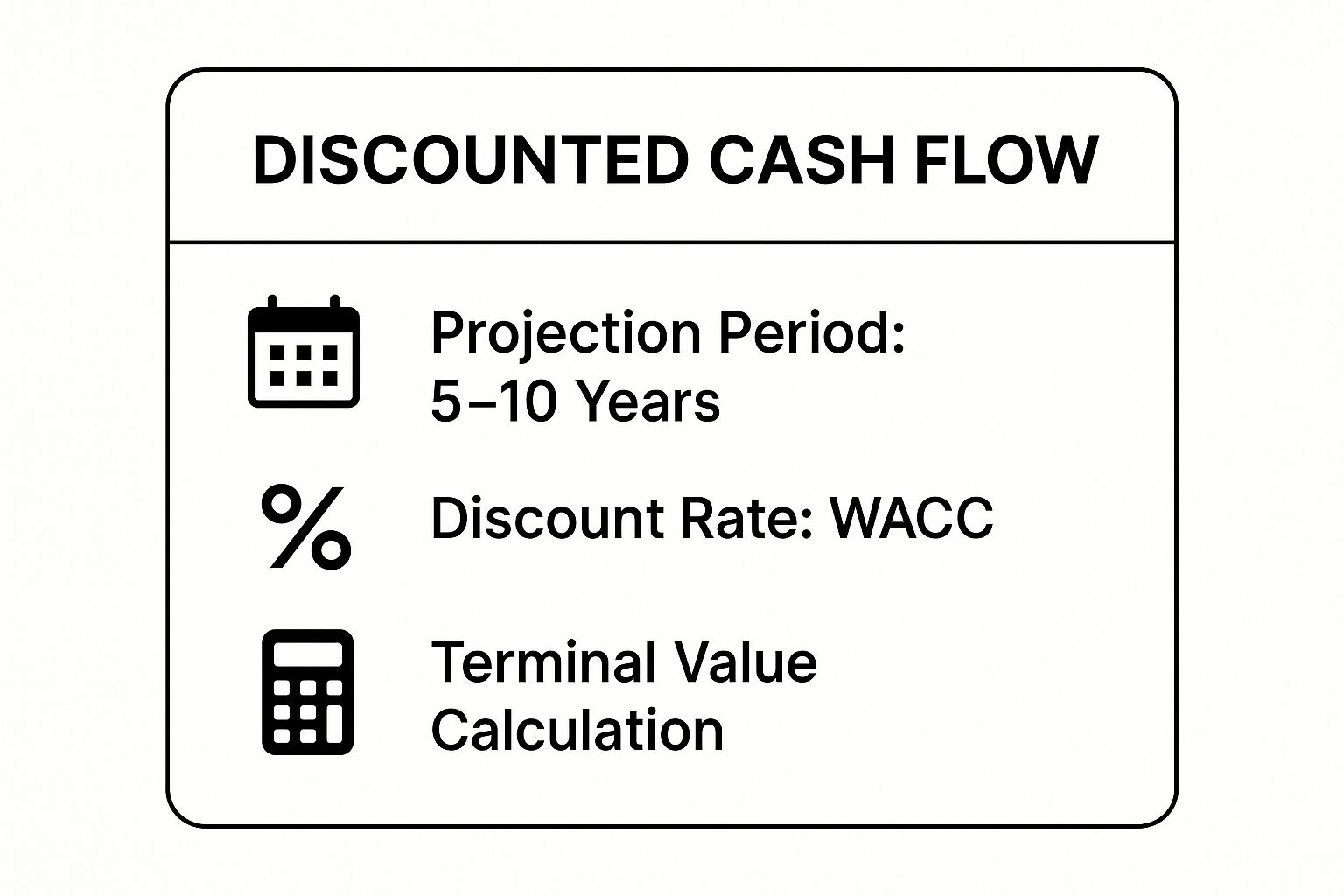For small business owners and entrepreneurs, a solid business plan is your roadmap to success. Yet, the most critical—and often most intimidating—part is the financial forecast. A vague estimate simply won't cut it when you're pitching to angel investors, applying for a small business loan, or mapping out your marketing plan. You need a credible, data-driven financial projection that proves your venture is viable and profitable.
But where do you start? What does a strong example of financial projection even look like for a small business or a new startup? This guide moves beyond theory to provide concrete, actionable examples. We will break down six distinct financial projection models, transforming them from complex spreadsheets into powerful strategic tools for entrepreneurs.
You will find annotated examples and downloadable templates tailored for different small business models, from SaaS startups to local service businesses. Our goal is to help you build a compelling financial narrative that aligns your core business strategy with your operational and marketing plans. By the end, you'll have the confidence and the tools to create projections that not only secure funding but also guide your most important strategic decisions for sustainable growth.
1. Discounted Cash Flow (DCF) Financial Projection
The Discounted Cash Flow (DCF) model is a cornerstone of financial valuation, estimating a business's worth by projecting its future cash flows and discounting them back to today's value. This method provides an intrinsic valuation, meaning it focuses on the business's ability to generate cash rather than on market sentiment or what similar businesses have sold for. For entrepreneurs and small business owners creating a business plan, a DCF model offers a powerful example of financial projection that can justify a valuation to investors or guide strategic decisions, like whether to expand.
At its core, the DCF process involves forecasting free cash flow (the cash a company generates after accounting for operating expenses and investments in things like new equipment) over a specific period, typically 5 years for a small business. These future cash flows are then discounted using a rate that reflects the riskiness of the investment. The sum of these discounted cash flows, plus a "terminal value" that represents the business's value beyond the forecast period, gives you its total estimated value.
Strategic Analysis: Why DCF is a Gold Standard for Business Plans
The true power of a DCF projection for a small business lies in its detailed, assumption-driven approach. Unlike simpler methods, it forces you to think critically about every driver of your business, from revenue growth rates and profit margins to how much cash you need to tie up in inventory. This granular analysis helps you, the entrepreneur, understand the operational levers that create the most value.
Key Strategic Insight: A DCF model isn't just a valuation tool; it's a strategic roadmap. It connects your long-term vision (e.g., opening a second location) directly to its financial implications (e.g., increased capital expenditures and future revenue streams), providing a clear financial narrative for your business plan.
Actionable Takeaways for Your Business
To build a credible DCF model for your small business, focus on these key actions:
- Build from the Bottom-Up: Base your revenue forecasts on tangible drivers from your marketing plan, like expected website traffic, conversion rates, and average customer spend.
- Conduct Sensitivity Analysis: Test how changes in key variables (like your growth rate or a key cost) impact the final valuation. This shows potential investors you understand the risks and key value drivers of your business.
- Create Multiple Scenarios: Develop base-case, best-case (optimistic), and worst-case (pessimistic) projections. This provides a realistic range of potential outcomes for stakeholders like lenders or partners.
The following infographic summarizes the core components needed to construct a DCF financial projection.

As highlighted, these three pillars form the mathematical foundation of your DCF analysis, translating your business strategy into a quantifiable valuation.
2. Three-Statement Financial Model Projection
The three-statement financial model is a foundational example of financial projection, integrating a company's income statement, balance sheet, and cash flow statement into one dynamically linked spreadsheet. This model ensures that all financial statements are consistent, providing a comprehensive and coherent view of a company's financial health. For small business owners and entrepreneurs, it is an indispensable tool for strategic planning, fundraising, and day-to-day operational management.
At its core, the model works by having the three core financial statements "talk" to each other. Net income from the income statement links to both the balance sheet (via retained earnings) and the cash flow statement. The cash flow statement's ending cash balance becomes the cash figure on the next period's balance sheet, and changes in balance sheet accounts are used to calculate cash flow. This interconnectedness ensures that an assumption change in one area, like your marketing plan driving higher sales, correctly ripples through your entire financial picture.
Strategic Analysis: Why the Three-Statement Model is Essential for Entrepreneurs
The true strength of a three-statement model is its holistic nature. Unlike projections that focus on a single metric, it forces a business owner to consider the full financial impact of their decisions. For instance, a marketing plan to rapidly scale sales (income statement) will require an understanding of its effect on inventory and accounts receivable (balance sheet), and ultimately, on the company’s cash position (cash flow statement). This prevents surprises, like running out of cash despite being profitable.
Key Strategic Insight: This model transforms your business plan from a set of isolated goals into a cohesive financial narrative. It demonstrates to investors and lenders that you have a deep understanding of how your operations, investments, and financing activities interact to drive performance and manage resources.
Actionable Takeaways for Your Business
To construct a robust three-statement financial model, concentrate on these critical actions:
- Start with Revenue Drivers: Begin by forecasting your income statement based on clear operational assumptions linked to your business model, such as sales volume, pricing, and cost of goods sold.
- Balance Sheet Schedules: Build simple supporting schedules for key items like inventory, accounts receivable, equipment purchases, and loan payments. These schedules will drive the changes that link your statements together.
- Audit and Stress-Test: Regularly check that your balance sheet actually balances (Assets = Liabilities + Equity). Use scenario analysis to understand how your projections hold up if sales are lower than expected or costs are higher.
The video below provides a visual walkthrough of how these three statements are built and connected.
As demonstrated, the integration of these statements is key. For a deeper dive into the mechanics, you can get answers to frequently asked questions about the Three-Statement Financial Model Projection.
3. Startup Financial Projection Model
A Startup Financial Projection Model is a specialized financial forecast tailored for early-stage companies that often lack historical data. Unlike established small businesses, startups cannot rely on past performance to predict the future. Instead, this model is built from the ground up, focusing on unit economics, customer acquisition costs (CAC), and customer lifetime value (LTV). For founders creating a business plan to secure seed funding, this type of financial projection is essential for demonstrating a scalable and profitable business model to potential investors.
This projection translates a startup's marketing plan and growth strategy into a financial narrative. It typically begins with assumptions about market size and customer acquisition channels, then projects key metrics like monthly recurring revenue (MRR) for SaaS companies or average order value for e-commerce startups. The model forecasts the "burn rate" (monthly net loss) and runway (how long until cash runs out), which are critical metrics for an entrepreneur managing cash flow in a high-growth environment.

Strategic Analysis: Why Unit Economics Are Your North Star
The power of a startup financial projection lies in its intense focus on the fundamental drivers of profitability at the individual customer level. While a traditional income statement looks at overall revenue and expenses, a startup model deconstructs success into its core components: how much it costs to acquire a customer and how much that customer is worth over their lifetime. This approach forces entrepreneurs to validate the viability of their business model long before reaching overall profitability.
Key Strategic Insight: This model is more than a fundraising tool; it's an operational compass for your small business. It directly links your marketing plan (e.g., cost per click on an ad) to your financial viability (e.g., LTV:CAC ratio), ensuring every dollar spent on growth is a calculated investment toward a sustainable business.
Actionable Takeaways for Your Business
To build a robust startup financial model for your business plan, concentrate on these critical actions:
- Model from Unit Economics Up: Start with your core unit metrics (CAC, LTV, churn rate) and use them to build your revenue and expense forecasts. This makes your projections more defensible to investors.
- Create Multiple Funding Scenarios: Show investors how different levels of investment will impact your growth trajectory, hiring plan, and runway. This demonstrates strategic thinking.
- Benchmark Your Assumptions: Since you lack historical data, research industry benchmarks for metrics like churn rates, conversion rates, and CAC to validate your assumptions. For more tools to get started, explore this Startup Financial Projection Model starter pack.
As highlighted, focusing on these key actions ensures your financial projection is a realistic and strategic asset for guiding your startup's journey from an early-stage idea to a scalable enterprise.
4. Real Estate Investment Financial Projection
A real estate investment financial projection is a specialized model used to forecast the financial performance of a property. While often used by large firms, it's a vital tool for small entrepreneurs looking to buy their first rental property or for a small business considering purchasing its own commercial space. This example of financial projection goes beyond a simple profit and loss statement, incorporating property-specific drivers like rental income, operating expenses, vacancy rates, and financing structures.
The model typically projects cash flows over a holding period, often 5 to 10 years, culminating in a potential sale. Key metrics derived from this projection include Net Operating Income (NOI), Cash-on-Cash Return, and Internal Rate of Return (IRR). These metrics help an entrepreneur make an informed decision by providing a clear picture of an asset's potential profitability and risk profile, which is a crucial component of any real estate-focused business plan.
Strategic Analysis: Why Real Estate Projections are Unique for Entrepreneurs
The power of a real estate financial projection for a small investor lies in its ability to model property-specific and market-specific variables. Unlike a typical business projection, it must account for factors like local rent growth trends, property taxes, capital expenditures for major repairs (e.g., a new roof), and the specific terms of a mortgage. This detailed approach allows an entrepreneur to understand how leverage (debt) magnifies returns and how sensitive the investment is to a tenant moving out or interest rates changing.
Key Strategic Insight: A real estate projection is not just an income forecast; it's a risk management tool. By modeling different scenarios for vacancy rates and rent growth, you can stress-test an investment to understand its resilience, making your business plan far more robust.
Actionable Takeaways for Your Business
To build a reliable real estate financial projection, focus on these critical actions:
- Incorporate Local Market Data: Base your rental income and appreciation assumptions on verifiable local market data from sites like Zillow or from local real estate agents, not generic national trends.
- Model Realistic Expenses: Include a realistic vacancy and credit loss factor (typically 5-10%) and budget for both routine maintenance and major long-term capital expenditures. Underestimating costs is a common failure point for new investors.
- Analyze Multiple Exit Scenarios: Model the sale of the property at different points in time to understand how market timing could impact your total return on investment.
5. Project Finance Financial Projection
The Project Finance model is a specialized and robust example of financial projection typically designed for large-scale, capital-intensive projects. While less common for the average small business, it's highly relevant for entrepreneurs in fields like small-scale renewable energy, local development, or specialized manufacturing who need to fund a single, large project on a standalone basis. This model secures financing based on the project's projected cash flows rather than the entrepreneur's personal assets or the existing business's balance sheet.
At its heart, a project finance model forecasts all cash inflows (e.g., from selling electricity or manufactured goods) and outflows (construction costs, operating expenses, debt service, taxes) over the project's entire lifecycle. The model meticulously calculates key financial metrics like the Debt Service Coverage Ratio (DSCR), which is critical for convincing lenders of the project's ability to repay its debt. The projection is built in distinct phases, from construction and ramp-up to full operation.
Strategic Analysis: Why This Model is a Game-Changer for Entrepreneurs with Big Ideas
The strategic power of a project finance model lies in its ability to isolate and manage risk for a single venture. It allows an entrepreneur to undertake a significant project without putting their entire existing business or personal finances at risk. This projection method forces a disciplined analysis of every potential variable, from construction delays and cost overruns to fluctuating prices for materials.
Key Strategic Insight: A project finance model is more than a financial forecast; it's a comprehensive risk management and financing instrument. It translates a complex, long-term operational plan into a bankable structure that aligns the interests of the entrepreneur, investors, and lenders, making bigger projects possible for small business owners.
Actionable Takeaways for Your Business
To construct a project finance model that lenders will trust, focus on these critical actions:
- Model Every Phase: Build separate, detailed forecasts for the construction, operational, and eventual wrap-up phases. Each has unique costs and risks that must be clearly articulated in your business plan.
- Incorporate Lender Covenants: Embed key lender requirements, such as minimum cash reserves, directly into your model. This demonstrates foresight and ensures your project plan is compliant from day one.
- Run Rigorous Scenario Analysis: Go beyond best/worst case. Model specific, plausible risks relevant to your project, like a 6-month construction delay or a 20% increase in key material costs, to stress-test the project's resilience.
This level of detailed financial modeling is a core component of a project's viability assessment. To explore this topic further, you can learn more about how it fits into a comprehensive feasibility study.
6. SaaS (Software as a Service) Financial Projection
A SaaS (Software as a Service) financial model is a highly specialized example of financial projection built for subscription-based businesses. This is the essential business model for thousands of startups and small tech entrepreneurs. Unlike traditional models that focus on one-time sales, the SaaS projection centers on recurring revenue, customer acquisition costs (CAC), and customer lifetime value (LTV). For any entrepreneur in the software space, this model is non-negotiable for a business plan, as it directly addresses the unique unit economics that investors scrutinize.

This projection type meticulously tracks metrics like Monthly Recurring Revenue (MRR), Annual Recurring Revenue (ARR), customer churn rate, and the LTV/CAC ratio. The goal is to demonstrate a scalable and profitable growth engine where the long-term value of a customer significantly outweighs the initial marketing cost to acquire them. This model is fundamental to the business plans of countless successful software startups.
Strategic Analysis: Why SaaS Metrics Tell the Whole Story for Entrepreneurs
The power of a SaaS financial projection is its focus on the customer journey and its long-term financial impact. It moves beyond simple profit and loss to tell a story about customer loyalty and sustainable growth. By forecasting cohort-based revenue and analyzing churn, a founder can pinpoint the health of their business model. For example, a projection might show that even with high initial marketing spend, a low churn rate leads to exponential revenue growth over time.
Key Strategic Insight: A SaaS projection is less about a single point-in-time financial snapshot and more about demonstrating a predictable revenue machine. It connects your marketing plan (e.g., cost per lead) directly to your long-term financial viability (e.g., LTV), proving to stakeholders that your growth is both strategic and sustainable.
Actionable Takeaways for Your Business
To create a compelling SaaS financial projection for your business plan, concentrate on these key actions:
- Model Cohorts Separately: Track customer groups based on when they signed up. This helps you understand how customer behavior and retention change over time, providing a more accurate revenue forecast for your business model.
- Forecast Upsell and Expansion Revenue: Don't just model new customer revenue. Project how much existing customers will spend over time by upgrading plans or adding seats—a key driver of profitability for small SaaS businesses.
- Benchmark Your Metrics: Compare your key SaaS metrics (like churn and CAC) against industry standards for similar startups. This provides crucial context for investors and helps you set realistic targets for your marketing and sales teams.
Financial Projection Models Comparison
| Model Type | Implementation Complexity 🔄 | Resource Requirements ⚡ | Expected Outcomes 📊 | Ideal Use Cases 💡 | Key Advantages ⭐ |
|---|---|---|---|---|---|
| Discounted Cash Flow (DCF) | Moderate to High 🔄🔄 | Requires detailed financial and market data | Intrinsic valuation, scenario & sensitivity analysis | Business valuation, strategic planning, loan applications | Based on fundamental cash flow, transparent |
| Three-Statement Financial Model | High 🔄🔄🔄 | Intensive modeling and accounting knowledge | Consistent financial statements, cash flow management | Business planning, operational budgeting, investor pitches | Ensures financial consistency, comprehensive view |
| Startup Financial Projection | Moderate 🔄🔄 | Relies on assumptions, market research | Focus on unit economics, burn rate, funding needs | Early-stage startups, fundraising, business plan creation | Tailored for growth and pivots, flexible |
| Real Estate Investment Projection | Moderate to High 🔄🔄 | Requires property and local market specifics | Rental income, cash flow, return metrics | Property acquisitions, small business real estate | Incorporates property-specific tax and cash flow aspects |
| Project Finance Model | Very High 🔄🔄🔄🔄 | Specialized expertise, complex data | Project cash flows, risk and debt analysis | Entrepreneurial projects in energy, manufacturing | Supports non-recourse financing, detailed risk analysis |
| SaaS Financial Projection | Moderate 🔄🔄 | Needs recurring revenue and customer data | Recurring revenue metrics, churn, unit economics | SaaS startups, any subscription business | Focuses on SaaS-specific metrics, growth insights |
From Projections to Profits: Your Next Steps
We've explored a diverse range of financial projection examples, from the rigorous Discounted Cash Flow (DCF) model to the dynamic SaaS projection. Each template offers more than just a place to enter numbers; it provides a framework for telling your small business's unique financial story. Viewing an example of financial projection is the crucial first step, but the real value lies in adapting these frameworks to your specific business plan and strategic goals.
Remember, a financial projection isn't a static document you create once for a loan application. It's a living roadmap that connects your vision to a viable financial reality, guiding everything from your marketing plan to your hiring decisions.
Turning Examples into Actionable Strategy
The key takeaway for any entrepreneur is that the right model depends entirely on your business model and goals. A pre-seed startup requires a different forecasting lens than a local service business, just as a real estate investor analyzes risk differently than a SaaS founder.
Here are the most critical insights to carry forward:
- Align Projections with Your Business Model: The startup projection prioritizes user growth and cash burn, while the three-statement model emphasizes stability and profitability. Always choose the model that best reflects your core operations and strategic priorities.
- Assumptions Are Your Foundation: Your projections are only as strong as the assumptions they are built on. Be prepared to defend your customer acquisition cost (CAC), churn rate, or market size estimates with solid research and data from your marketing plan.
- Connect Projections to Operations: Use your financial model to stress-test your marketing plan. Can you afford your proposed ad spend? What sales volume do you need to achieve to justify hiring a new team member? Your forecast is the bridge between your ideas and your budget.
Your Path Forward: Building a Resilient Business
Mastering the art of the financial projection is a non-negotiable skill for any serious entrepreneur or small business owner. It empowers you to make smarter, data-driven decisions, transforming your business from a reactive entity into a proactive one. This is how you build a more resilient, fundable, and ultimately, more successful enterprise. Don't let the complexity of the numbers intimidate you; instead, see them as the language of business growth.
By applying the strategic analysis and actionable takeaways from each example of financial projection we've dissected, you are now equipped to build a forecast that not only impresses investors but also serves as your trusted guide on the path to profitability.
Ready to move from theory to execution without getting lost in complex spreadsheets? GrowthGrid leverages AI to generate comprehensive business plans, complete with detailed financial projections tailored to your specific industry and business model, in just minutes. Build your investor-ready financial forecast today and turn your vision into a fundable plan at GrowthGrid.
